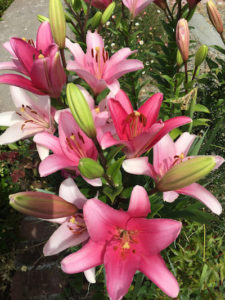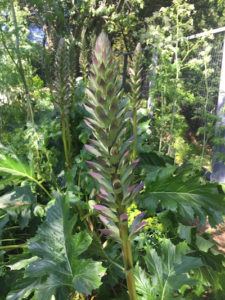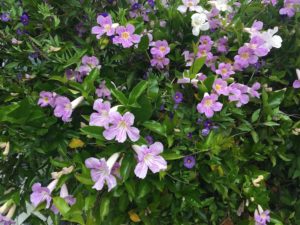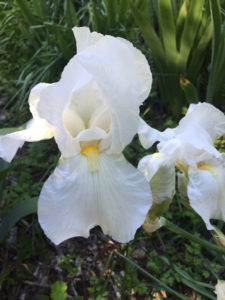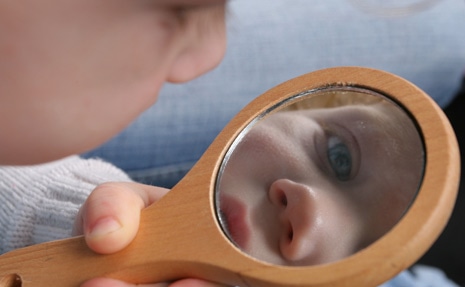“What you plant now, you will harvest later.” Og Mandino
It’s the time of year when kids are excitedly looking towards the play-filled days of summer while parents are wondering how they will juggle all of their children’s activities-swim meets, fairs, camps, baseball tournaments, concerts, and, possibly a move. During the summer, many people are uprooted and transplanted to another location. Sometimes the disruption is just across town and sometimes it is across the country or across the globe.
It’s challenging and often a shock to our systems getting settled, making friends, and building a new garden. When plants, trees, and shrubs are moved, they also go through an instance of distress. It doesn’t matter if they are being moved from one part of the garden to another or across the continent to a new home, as directors of our landscapes, we have a responsibility to give the transplants a good foundation for their new environs. Spring, early summer, and late fall are traditionally optimal times for this transition. Follow the suggestions below for a successful uprooting and transplanting experience.
Transplanting Tips: When we transplant seedlings, trees, shrubs, or other plants, they experience shock. To diminish the negative effects of being moved, these easy steps will help provide strength and adjustment to the new environment.
1. Prevent shock effectively by gently uprooting. Dig up as many of the roots as possible and don’t shake the dirt off. Refrain from cutting roots, unless a plant has been root bound.
2. To strengthen the plant, cut it back about 1/3 and make sure to remove any flowers, dead leaves, or dying limbs. This will help the plant regenerate more quickly without exerting extra energy. Don’t over prune or you’ll worsen the effects of shock.
3. Provide clean, nutrient rich soil for the transplants. Buy bags of topsoil or potting soil, depending on where you are transplanting.
4. Before transplanting, boil eight cups of water with eight tablespoons of sugar. Stir and allow cooling to room temperature. Before putting the roots in the new soil, pour two cups of this liquid on the transplant. Save two cups for each plant after the transplant. This recipe is good for two plants. Increase recipe to make as much as needed.
5. Dig a large enough hole for the transplant as a major cause of shock is placing a plant in too small of a hole and not providing enough water.
6. After planting in your new location or container, pour the remaining two cups of sugar water on the plant.
7. Water the transplant thoroughly. This helps the roots settle into the new soil.
8. Monitor water on a regular basis. Proper watering is essential for rapid recovery.
9. Wilted, shriveled, scorched, rolled, curled, or yellow leaves are indicators of shock. An immune system booster for transplants is to treat with aspirin water. Smash two or three aspirins in a gallon of water. Trickle water on your plants to increase plant health.
10. Add three to four inches of organic mulch around the plants to reduce symptoms. Mulch will insulate the plant, maintaining a consistent temperature while prevent erosion.
11. Continue to water deeply yet be diligent not to drown the roots.
12. Give the plants time to recover and settle into their new home. Have patience. It’s shocking to be uprooted!
Cynthia Brian’s Mid Month Gardening Guide o WATER deeply and less frequently. As summer approaches our gardens will be thirstier. By watering deeply, you encourage strong roots. If you want to use a hose and sprinkler, buy a water timer that can be attached to a hose bib. Price is only about $23-30 and will save you time, money, and waste. o GROW roses on your patio or deck in containers where you have plenty of sunlight. Use high quality soil and tree rose of your choosing for blooms and beauty all season long. Cover a mailbox with a climbing rose to increase your curb appeal. o SNIP the tops off mint to enjoy in multiple refreshing uses including salads and mojitos.
o SPREAD the seeds of Love in a Mist after they have finished blooming. The seed pods can be crushed and shaken in areas where you want more flowers next year.
o PRIVACY screens are all the rage in neighborhoods. Prune privets to a height and width you want for a quick green fence or plant clumping bamboo. (This bamboo does not get out of control or tear up your concrete)
o GIVE the gift of living plant to your graduate. With care, a plant will be a constant reminder of your ongoing love.
o PROTEST water rate increases by writing a letter to let EBMUD. Send to EBMUD, MS218, PO Box 24055, Oakland, Ca. 94623-1055
o CELEBRATE Dad on Father’s Day. A well-made tool or herbs for his barbecue marinades could be right up his alley.
o WATCH for mosquito larvae in birdbaths and other still water. Empty water from all containers or add animal safe Dunks.
o WIN $50,000 for your Garden: As a judge in America’s Best Gardener Contest, I encourage you to enter your best garden photo. The top prize is $50,000. Wish I could enter! http://www.americasbestgardener.com
o Harvest what’s ripe and ready: • Mulberries (you may have to battle the birds) • Cherries (Ditto to above) • Wild Plums • Nectarines, • Kale • Mints Enjoy our final days of spring. Summer sun and fun is quickly approaching. Congratulations to all of our graduates and a very Happy Father’s Day to all the great daddies. Kudos to you all. Happy Gardening and Happy Growing!
Read more at https://www.lamorindaweekly.com/archive/issue1108/Digging-Deep-11-Tips-for-uprooting-and-transplanting-gardens.html Cynthia Brian, The Goddess Gardener, is a New York Times best selling author, actor, radio personality, speaker, media and writing coach as well as the Founder and Executive Director of Be the Star You Are1® 501 c3. Tune into Cynthia’s Radio show at www.StarStyleRadio.com Her new book, Growing with the Goddess Gardener will be available soon! Hire Cynthia for your next project. Cynthia@GoddessGardener.com www.GoddessGardener.com 925-377-STAR



